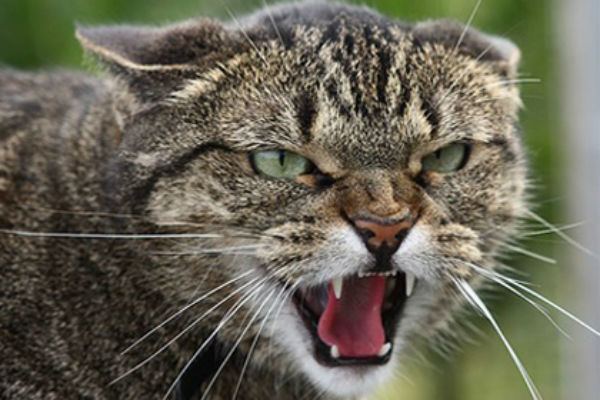 | ||
A feral cat is a cat that has been born to other ferals or from stray cats as opposed to domesticated cats. These ferals are unaccustomed to human interaction. Feral cats are usually considered to be distinct from stray cats, which are socialized cats who no longer live in homes, but could potentially be reintroduced successfully.
Contents
- Definition
- Farm cat
- Ships cat
- History
- Behavior
- Colonies
- Socialization
- Diet and predators
- Life span and survival
- Disease prevalence
- Transmission to humans
- Distribution and habitat
- Control and management
- Effects on wildlife
- Hybridisation with wild felids
- References
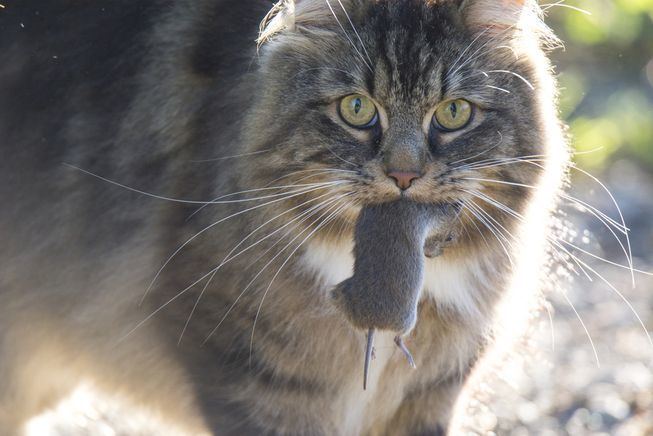
This article discusses the definition, history, behavior, health, distribution and habitat, control and management, and effects on wildlife. Further subtopics include the definition, behaviors and characteristics of both farm cats and ship's cats and how they relate to feral cats.
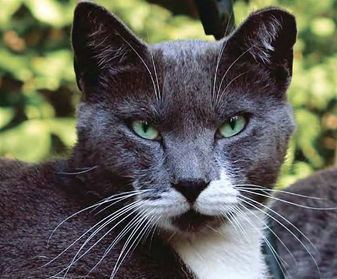
Definition
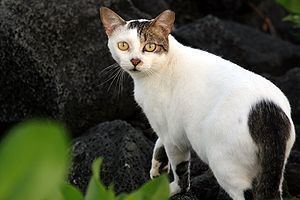
Feral is an adjective defined as existing in a wild state, not domesticated. It can also be used to describe a quality of wild animals as ferocious or brutal. The meaning of the term feral cat varies between professions and countries, and is sometimes used interchangeably with other terms such as free-roaming, street, alley, or community cat. Feral can also mean reverting to the wild state from domestication therefore, some of these terms are also used to refer to stray cats, although stray and feral cats are generally considered to be different by rescuers, veterinarians, and researchers. Stray cats are socialized cats who no longer live in homes, but could potentially be successfully reintroduced to a home environment.
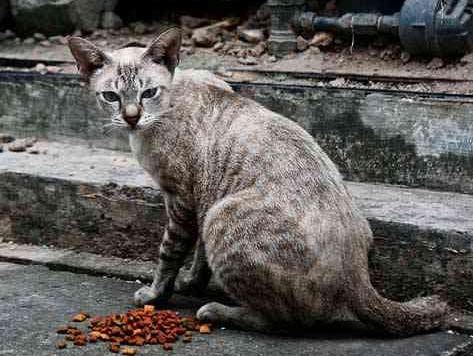
A 2013 article in the Journal of Feline Medicine and Surgery found that rescuers and veterinarians in the United Kingdom tended to distinguish feral cats from domesticated cats based on traits such as their levels of socialization, ownership, and confinement, and on the amount of fear of, interaction with, and dependence upon humans. They found that rescuers and veterinarians tended to agree that feral cats were cats that had not had much human contact (particularly before eight weeks of age), would try to avoid humans, and would prefer to escape rather than attack a human. However, veterinarians and rescuers disagreed on whether a feral cat would tend to hiss and spit at or attack a human during an encounter, and disagreed on whether adult ferals could potentially be tamed. The article provided a composite definition of a feral cat as a cat that would choose not to interact with humans, could survive with or without human assistance, and would hide or defend itself when trapped rather than allowing itself to be handled.
A survey of rescuers and veterinarians in the United States found that there was no widely accepted definition of a feral cat. Many facilities used waiting periods to evaluate whether a cat was feral by observing whether the cat became less afraid and evasive over time. Other indicators included the cat's response to touch with an inanimate object, and observation of social behavior from the cat in varying environments (in response to human contact, with a human nearby, or when moved to a quieter environment). The American Society for the Prevention of Cruelty to Animals defines community cats as either cats who were born and raised in the wild, or domestic cats who have been abandoned or lost and turned to wild ways in order to survive.
The Australian government categorizes cats who have no interaction with or assistance from humans as feral, and unowned cats who rely on humans as semi-feral or stray.
Farm cat
Farm cats (also called barn cats) are cats that live on agricultural properties in feral or semi-feral condition. They primarily live outdoors, usually sheltering in outbuildings. They hunt vermin such as rodents and other small animals that live in or around outbuildings and farm fields.
The need to keep rodents from consuming or contaminating grain crops stored for later human consumption may be the original reason cats were domesticated. They are still commonly kept for the purpose of catching undesired vermin found on farms and ranches, which would otherwise eat or contaminate crops, especially grain or feed stocks.
Ship's cat
Ship's cats are typically feral or semi-feral, and were once common features on many trading, exploration, and naval ships. Cats were primarily brought aboard to catch mice and rats, which can cause damage to ropes, woodwork, and eventually as technology progressed, electrical wiring. Rodents also presented a threat to the stores the ship carried, both as cargo and as food for sailors. Rats and mice were also sources of disease, which was dangerous for ships at sea for long periods of time. Cats have been officially banned from some commercial and military fleets, though they are sometimes still kept privately by sailors.
History
Although scientists do not agree on whether cats were originally domesticated in Egypt or if they were introduced there after domestication, the spread of cats throughout much of the world is thought to have originated in Egypt, where they were popular and effective controlling mouse populations. Traders from Phoenicia brought them to Europe to control rat populations, and monks brought them further into Asia. Roman armies also helped with the spread, eventually bringing them to England. Since then, cats continued to be introduced to new areas, often by sailors or settlers. Cats are thought to have been introduced to Australia in either the 1600s by Dutch shipwrecks, or the late 1700s by English settlers. These domesticated cats began to form feral populations after their offspring began living away from human contact.
Behavior
Some behaviors are commonly observed among feral cats, although there is disagreement among veterinarians, rescuers, and researchers on the prevalence of some. In a free-roaming environment, feral cats avoid humans. They do not allow themselves to be handled or touched by humans, and back away or run when they are able to do so. If trapped, they may hiss, growl, bare their teeth, or strike out. They remain fairly hidden from humans and will not approach, although some feral cats gradually become more comfortable around humans who feed them regularly.
Colonies
Feral cats often live in colonies, groups of feral cats that live together in one territory, often near food sources and shelter. Researchers disagree on the existence, extent, and structure of dominance hierarchies within feral colonies. Different types of hierarchies have been observed in feral colonies, including despotic and linear hierarchies. Some colonies are organized in more complex structures, such as relative hierarchies, where social status of individual cats can vary on their location, the time of day, or the activity the cats are engaged in (particularly feeding and mating).
When a human decides to care for a feral colony, it is often called a managed colony. The care given can include regularly supplying food and water to the cats, providing shelters, helping with trap-neuter-return programs, providing continued veterinary care, finding foster homes for cats that can be socialized for eventual adoption, and working to educate people who live in the neighborhood.
Socialization
Feral kittens can be trapped and socialized, then adopted into a home. The age at which a kitten becomes difficult to socialize is not agreed upon, but suggestions generally range from seven weeks to four months of age. Although older cats can sometimes be socialized, it is a very long and difficult process, and the cat rarely becomes friendly and may remain fearful.
In a 2013 study of participants from the United Kingdom, rescuers tended to be more willing than veterinarians to attempt to tame adult feral cats. Veterinarians tended to be more opposed to this practice, with some expressing concerns for the welfare of such a cat in a home environment. In a 2010 study of veterinarians and rescuers in the United States, 66% of respondents had socialization programs for kittens, and 8% for adult cats.
Diet and predators
Feral cats primarily subsist on food scavenged from garbage when it is available to them. They also eat animals they kill, and carcasses of animals already dead. Feral cats living in managed colonies are fed cat food by volunteers.
Domesticated and feral cats have been observed to prey on a wide variety of both vertebrates and invertebrates. Cats typically prefer smaller animals with body weights under 100 grams (3.5 oz), particularly mammals, birds, and lizards. A meta-analysis of studies of cat diet found that cats preyed on over 1,000 species. The analysis found house mice, European rabbits, black rats, house sparrows, and common blackbirds were some of the most commonly observed prey species.
Feral cats in Australia prey on a variety of wildlife. In arid and semi-arid environments, they eat mostly introduced European rabbits and house mice. In arid environments where rabbits do not occur, native rodents are taken. In forests and urbanized areas, they eat mostly native marsupials (particularly the common ringtail possum) and rodents.
Feral cats may be mesopredators or apex predators in some local ecosystems. In others, they may be preyed upon by animals such as feral dogs, dingoes, coyotes, and birds of prey.
Life span and survival
Feral cats in managed colonies can live long lives. A number of cats in managed colonies in the U.K. died of old age. In the U.S., the last cat in a managed colony in Washington, D.C. died at age 17, and Zorro, the last cat of a colony at the Merrimack River in Newburyport, Massachusetts, died in 2009 at age 16.
A long-term study of a trap-neuter-return (TNR) program on a university campus in Central Florida found that, despite widespread concern about the welfare of free-roaming cats, 83% of the cats studied had been present for more than six years, with almost half first observed as adults of unknown age. The authors compare this result to a 1984 study that found the mean lifespan for domesticated cats was 7.1 years.
Without human assistance, feral kittens are expected to have a high death rate, with approximately 50% dying within the first year.
Adult feral cats without human assistance have been found in surprisingly good condition. In Florida, a study of feral cats admitted to a trap-neuter-return program concluded that "euthanasia for debilitated cats for humane reasons is rarely necessary". A further study of over 100,000 community cats (feral and stray) admitted to TNR programs in diverse locations of the U.S. resulted in the same 0.4% rate of euthanasia for debilitating conditions. The body condition of feral cats entering a TNR program in Florida was described as "generally lean but not emaciated". However, many community cats had suffered from parasites such as fleas and ear mites before entering TNR programs.
Disease prevalence
Feral cats, as with all cats, are susceptible to diseases and infections including rabies, bartonellosis, toxoplasmosis, plague, parasites, feline immunodeficiency virus (FIV), feline leukemia virus (FeLV), rickettsial diseases, and feline respiratory disease complex (FRDC, a group of respiratory illnesses including feline herpesvirus type 1, feline calicivirus, Chlamydia felis, and Mycoplasma felis).
Feline leukemia virus and feline immunodeficiency virus belong to the Retroviridae family, and both cause immunosuppression in cats, which can increase their susceptibility to other infections. Research has shown that the prevalence of these viruses among feral cat populations is low and is similar to prevalence rates for owned cats in the United States.
Researchers studying 553 feral cats in Northern Florida in the United States tested them for a number of infections that could be detrimental to feline or human health. The study found the most prevalent infection to be Bartonella henselae, the cause of cat-scratch disease in humans, with 33.6% of the cats testing positive. Feline coronavirus was the next most common infection, found in 18.3% of the cats, although they noted that the antibody levels were low in most of the cats who tested positive, and concluded that the cats they tested did not appear to be a greater risk for shedding the virus than pet cats. Researchers studying 96 feral cats on Prince Edward Island in Canada found that feline roundworm was the most common infection in cats in that colony, afflicting 34% of cats. This was followed by Toxoplasma gondii, which was detected in 29.8% of cats, although only one cat of the 78 for whom fecal samples were available was shedding T. gondii oocysts. They did note that most fecal samples collected indicated the presence of one intestinal parasite, with some samples indicating the presence of multiple parasites.
Transmission to humans
The Center for Disease Control and Prevention has warned about the rabies risk associated with feral cats. With 16% of people infected with rabies from exposure to rabid cats, cats have been the primary animals responsible for transmission of the virus to humans in the United States since the efforts to control rabies in dogs in the 1970s. In 2010, there were 303 rabid cats reported within the United States. Although some colony management programs involve administering rabies vaccines, the need to revaccinate every few years makes this challenging to maintain. Furthermore, lack of documentation can mean that contact with vaccinated feral cats may still require post-exposure treatment.
The study of feral cats on Prince Edward Island warned of "considerable zoonotic risk" for transmission of intestinal parasites. Although the authors noted that their study did not provide evidence for great risk associated with T. gondii in cats, they advised that the risk should still be considered, as the infection in humans can cause significant health problems, and cats who are not otherwise transmitting the infection can begin shedding the virus in times of stress.
Distribution and habitat
Feral cats live on all continents except for Antarctica. The worldwide feral cat population is estimated to be at least 100 million. The United States' feral cat population is estimated at 60 million, Australia's at 12 million, and Britain's at one million.
Japanese island Aoshima is populated with feral cats.
Cats are found on many remote islands, such as the Hawaiian Islands, where they are an invasive species. Based on microsatellite genetic tests it was determined that these cats have a mainly European ancestry. These cats’ globetrotting ways can be attributed to Humans’ ship trading routes in the 19th century.
Most feral cats have small home ranges, although some are more transient and travel long distances. The home ranges of male feral cats, which are generally two or three times larger than those of female cats, are on average under 10 hectares (25 acres), but can vary from almost 300 hectares (740 acres) to under 1 hectare (2.5 acres). This variance is often due to breeding season, access to females, whether the cat is neutered, age, time of day, and availability of prey.
Control and management
Trap-neuter-return (TNR) involves trapping feral cats, spaying or neutering them, and then returning them to the place where there were originally trapped, where ongoing care is provided by caregivers. When neutered, the cats receive vaccinations against rabies, and attention to other medical needs, such as dental care and flea treatments. TNR programs are prevalent in several countries, including England, Italy, Canada, and the United States, supported by many local and state governments. Various long-term studies have shown that TNR is effective in stopping reproduction and reducing the population over time. TNR results in fewer complaints, as nuisance behaviors diminish following neutering, and the quality of life of the cats is improved. The practice is reported to save money and garner more public support and better morale than efforts that involve killing cats.
The International Companion Animal Management Coalition advocates for TNR as a humane method of controlling feral cat populations. In the U.S., the practice is endorsed by the Humane Society of the United States and the National Animal Control Association. While the United States Department of Defense does not formally advocate TNR, it provides information to military installations on how to implement TNR programs, with the main message that population control programs must be humane.
The multiple, managed, feral colonies at the Colosseum in Rome exceed 250 cats. Other notable colonies include the Canadian Parliamentary Cats and the cats of Jerusalem.
In 2011, an Australian study emphasised the need to monitor the effects of culling programs after infrared cameras found that the culling of feral cats led to an increase in feral cat populations in the culled areas. It was thought that only dominant cats were being baited and trapped during such operations. After the removal of dominant cats, there was an influx of subordinate animals to the area which unlike the dominant cats, did not venture into the traps. Within a year cat numbers in culled areas stabilised to original numbers.
Effects on wildlife
Cats hunt small prey, such as rodents and birds. Free-ranging cats kill one to four billion birds and six to 22 billion mammals annually in the forty eight contiguous states of the United States. Feral cats kill the majority of birds. They are the largest source of human caused killing of birds.
Sometimes feral cats kill non-native pests. Feral cats have been intentionally introduced to some areas as a pest control strategy. In the 1800s, thousands of cats were introduced near settlements in Australia that had developed near gold dig sites and farms as an attempt to manage populations of mice, rabbits, and rats.
Hybridisation with wild felids
Feral cats have interbred with wildcats to various extents throughout the world, the first reported case occurring more than 200 years ago. The significance of hybridisation is disputed. Older documentation suggests that the wildcat was a separate species from the domestic cat, but modern genetic analysis has shown that the domestic cat is a domesticated version of the near-eastern wildcat (Felis silvestris lybica). In some locations, high levels of hybridisation have led to difficulties in distinguishing a "true" wildcat from feral domestic and domestic hybrid cats, which can complicate conservation efforts. Some researchers argue that "pure" wildcats do not exist anymore, but others dispute this.
One study in Scotland suggests that while "true" Scottish wildcats are unlikely to exist, the current wildcat population is distinct enough from domestic cats to be worth protecting, genetics research is still underway as part of the Wildcat Haven project in Scotland, which has reported success protecting wildcats from hybridisation with widespread trap-neuter-return work. Wildcat populations' notable gene introgression exists also in Italy, Hungary, Spain and Portugal. For a discussion of this issue see The Encyclopedia of Mammals, OUP, pages 656–657.
